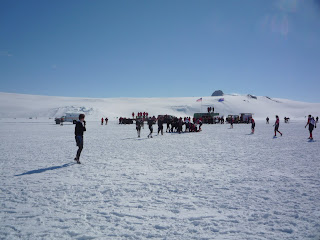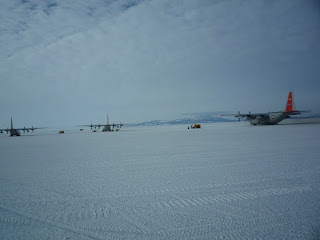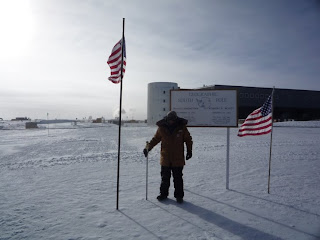Yesterday I got a chance to make a quick trip to the south pole. Every department gets a few seats on these "sleigh ride" trips, to pass around to the folks in the group. In our department, the trips were prioritized by time on ice, so the highest likelihood of a trip would be to someone who has been coming down for a long time, and has never been to pole before. I'm in my 32nd month on ice, so I'm kind of a medium-timer. I went to pole to work back in 2000, before the new station was built. The old dome was still there, and was one of the wildest places I've ever been. Now the dome is gone, the new station is finished, and it's quite a different place from before. Since I had been to NPX (as the Amundsen-Scott South Pole Station is known), I was out of the running for a sleigh ride. At the last minute the guy who was scheduled to be the group leader bailed, so they called me. I guess my previous pole experience somehow qualified me to be the leader.
The pole station receives most of its fuel by air. New York Air National Guard LC-130s take off from McMurdo fully loaded with fuel, and offload a bunch of it when they get to pole. Some flights, like the one I was on, carry no cargo and very few passengers, serving strictly as a tanker. I talked to the pilot a little about it after we got back, and he explained the sleigh ride phenomenon. If the plane is completely full of fuel and there is still a little bit of available weight to take, they take as many people for a ride as they can, as a morale trip. Of course, very few people on earth get to go to the pole, so it's a real treat.
We loaded up on a Delta, and headed out to Pegasus. Everything moved pretty quickly-- we got on the plane shortly. There were nine of us on the trip, from a broad cross-section of the McMurdo population. Two of us were from IT, one from supply, one from the galley, a heavy equipment operator, a Kiwi scientist, an FEMC GA, a mechanic, and a cargo guy. The trip down was uneventful, and we got to see some fantastic scenery on the way. We even got to take turns going up into the cockpit. I went up there just as we approached the Beardmore Glacier. The picture that is taken straight out the front is of the Beardmore, though it's so huge and white you can't see it well. The picture just below the photo of me looks like it's nothing, but it was a really cool sundog that followed us. As the shadow of our plane moved across the tops of the clouds, it was surrounded by a bright rainbow ring. I guess the speck of our plane caused the light to refract around us like a prism. It took us about three hours to get to NPX, and everything was rushed. The plane sat in the fuel pits with props turning, offloading 60,000 pounds of fuel while we were on our boondoggle. They told me to have the group back to the plane, ready to board in 25 minutes. Considering all nine of us would want to have our pictures taken at the ceremonial pole and the actual geographical south pole, and get at least a brief look at the inside of the new station, 25 minutes was pushing it, to say the least. Luckily the pole is less than a quarter of a mile from the plane, and is pretty close to the station. I cracked the whip, and tried to get them to stick together and move along. (The picture of me at the ceremonial pole didn't turn out well, but others got pictures of me that I haven't received yet.)
The sleigh ride before ours had really angered the Guard guys. They had diddled around too long, and made the plane wait, which is a huge no-no. The plane offloads as much fuel as they can, leaving just enough to safely make it back to McMurdo with a little reserve. If they have to idle on the taxiway for any time, waiting for the boondogglers to return, they could actually have to refuel the plane to take off, which would enrage them. They warned us not to be late like the last group. There was even talk of ending the sleighrides due to their recent bad experience. I did the best I could to nag and cajole the wide-eyed sleigh riders back to the plane. We were a couple of minutes late, but they weren't tapping their toes and looking at their watches yet.
To me, the most incredible part of the trip is flying over the Beardmore Glacier. It is unimaginably huge-- something like a hundred miles long, and four or five miles wide in places (http://en.wikipedia.org/wiki/Beardmore_Glacier). That's the route Robert Scott took when he made it to the pole (but not back) in 1912. To fly over that massive river of ice, knowing that men dragged heavy sledges loaded with supplies over it-- incredible. The cravasses and seracs are pretty much continuous for mile after mile, and are so huge that we could easily see them from 20,000 feet above. Wow. The Transantarctic Mountains are just amazing, with huge ice falls, cravasse fields, and valley glaciers. The plateau above is a featureless expanse of white, clear to the pole and beyond. The ice sheet below and the Ross Ice Shelf beyond that (heading back to McMurdo) are pretty much flat and white, too. That is until you get to the strange lump of Ross Island, with it's huge volcano, and Home Sweet Home on the end of Hut Peninsula.
Wednesday, January 27, 2010
Tanker




Our fuel tanker has come and gone over the last week. In its first attempt at docking, it pinched too much ice between its hull and the ice pier-- it took them about a day to get it docked right. It brought in five million gallons of fuel, which was offloaded through a mass of big fuel hoses. Our Comms department put wireless internet and two radio telephones on the tanker for their use over the couple of days they were here in port. The icebreaker continues to cruise around in the turning basin and the shipping channel, making ready for the American Tern, the huge cargo ship that's coming to bring us more stuff, and take away our junk and trash. Ship offload is a big deal here-- it's a crazy time with trucks running night and day, and supply people running around like chickens. My department will be really busy, too, but for other reasons. We are starting to fly out to round up all of our repeaters from mountain tops, and other gear from field camps. Never a dull moment.
Tuesday, January 19, 2010
F6





Yesterday I got to fly out to the McMurdo Dry Valleys to fix a radio telephone at F6 camp at Lake Fryxell. It was a pretty nice day, and we had good luck with the comms gear. I had a little bit of time, so I hiked from the F6 hut about halfway up to the Commonwealth Glacier. I was afraid our helo ride out would arrive before I got back, so I cut short my hike and headed back to the hut. We landed on Hjorth Hill on the way out to drop off a couple of techs, and again on the way back out to pick them up. What a cool job I have, getting paid to fly around in helicopters to exotic spots!
Saturday, January 16, 2010
Rugby on Ice


Last weekend we (the McMurdo community) answered the challenge to play the Kiwis of Scott base in a game of rugby out on the Ross Ice Shelf. It was an incredibly gorgeous day out there. I was wearing a long underwear shirt, and was hot, even with my jacket off. I basked in the sun while watching the Kiwis pummel the hapless Americans. I imagine most of the Kiwis grew up playing rugby, and probably none of the Americans had ever played it, or even seen a game before working in the Antarctic program. I think it's an awesome game. It's huge in New Zealand, so we get exposed to it quite a bit. There are two types, rugby league and rugby union. Most of the folks I know think only rugby union is the "real" rugby. Both are much more interesting than American football to watch-- much more action and less annoying penalties and breaks. For our ice game, a rugby field was set up out on the ice shelf, near Snowmound City, where the FSTP (Field Safety and Training) folks take us out to Happy Camper School. It's perfectly flat out there, which is why I suppose the Kiwis chose the location, though it was far from either of our bases. They were playing on about a thousand feet of glacial ice, floating on the Ross Sea. http://www.activenewzealand.com/rugby-rules.php
Hjorth Hill




A week or so again, I got to fly out in a helo to fix a radio telephone at Hjorth Hill. We have a small comms hut there with various repeaters that look down on Lake Fryxell, in the McMurdo dry valleys. (http://en.wikipedia.org/wiki/McMurdo_Dry_Valleys, http://www.mcmlter.org/) It was a cloudy day, and not so hot for photos. It was relatively warm, though, and not too unpleasant to hang out there for a while. Particularly neat rocks up there-- I did some poking around while waiting for the other half of our team to get situated at the F6 camp on Fryxell, and start looking at the phone link. On the way out and back on the helo, we saw the icebreaker Oden, just beginning to open up the shipping channel to McMurdo for the fuel tanker and the big supply ship to come in. Seeing the icebreaker like that was a tangible reminder that the summer is coming to an end soon!
Saturday, January 9, 2010
More Science


A couple of weeks ago, I got to install a wireless data network to some "beakers" (scientists) who are working on a program to map the topology under the ice. The project is called CRESIS (not sure what that stands for...). They have an 1100 pound remotely-piloted aircraft (UAV) that carries ground penetrating radar, and flies back and forth to get a profile of the rock under the polar ice. They have two UAVs (Unmanned Aerial Vehicles) they use. The bigger one is 1100 pounds-- almost the size of a private aviation aircraft. There is some really cool science going on down here.
Subscribe to:
Posts (Atom)

























